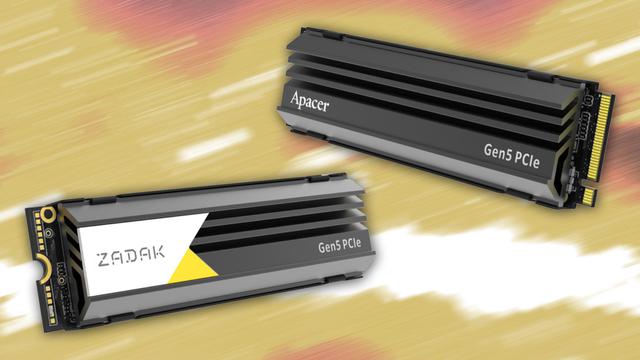It's an exciting time in the PC hardware space. While we've been spending our time testing DDR5 memory and 12th-gen Intel processors, we're also on the cusp of some interesting storage innovations. Microsoft's DirectStorage API was released just a few weeks prior, and as PCIe 4.0 SSDs have become increasingly affordable, PCIe 5.0 has debuted on Intel motherboards, soon to be replicated with AMD's next generation platform. With that in mind, we had plenty of questions ready when we were approached by storage giant Kingston to speak to one of their longest-serving executives on the SSD side of the firm.
What follows is an interview with Tony Hollingsbee, EMEA Business Manager - SSD at Kingston. He's been at the company for two decades, and therefore had a hand in the transition from hard drives to SATA and then NVMe SSDs. We asked him about what the next big storage technologies would mean for gamers, whether Kingston would be up for creating SSDs for the Xbox, not just the PlayStation 5 and PC, and what kind of testing drive manufacturers do when preparing their latest products for the public - and reviewers - to test out. Enjoy!
Having been at Kingston for 20 years, you must have overseen the switch from HDD to SSD as the storage tech of choice, and again from SATA to NVMe SSDs. Can you speak to what those transitions were like from your perspective?
Having overseen the introduction of Kingston’s first SSD products at launch I have witnessed the rapid growth of our SSD business from a small, somewhat experimental set of products, to a major part of our business and consumer of NAND.
As with all new technology there was some resistance to overcome, namely concerns regarding potential failure rates, data loss/data retention and drive endurance. It soon became apparent that these concerns were unwarranted and that the significant benefits that SSDs offered in terms of performance accelerated the rate of adoption.
There have been various stages in terms of development of SSD technology, but the most notable is the transition from SATA to NVMe where the true benefits of Solid State Storage really come into play without the legacy limitations of SATA, a platform developed with HDDs in mind.
Are drives optimised towards different use cases - e.g. enterprise vs content creation vs gaming? If so, what attributes or specifications are key to each, and how are drives designed to sate those needs?
Absolutely. The biggest divergence in SSD configurations is between enterprise and datacenter usage, where predictable latency and endurance are the key specifications customers are looking for, and configurations for gaming and content creation, which both require high bandwidth and high performance first and foremost. Endurance is of course important in these scenarios too, but it's not a priority in quite the same way it is in the enterprise.
Obviously, the Fury Renegade slots right into the PS5; would you be able and willing to create a similar solution for Xbox with Microsoft's co-operation?
This clearly depends on Microsoft's future Xbox strategy, but there is no reason we would not.
For gaming, we currently recommend SATA or PCIe 3.0 drives over PCIe 4.0 alternatives as the former offer much better value and near-identical performance. Is that likely to change any time soon?
NVMe isn't simply about improved performance and throughput. As a more modern, more advanced specification than SATA, it is fast becoming the dominant SSD technology. DirectStorage is a great example. This will have a big impact on gaming, and it is only supported with NVMe SSDs, and we predict it will lead to NVMe eventually becoming a must have for gaming.
In the meantime we continue to experience rapid growth in our NVMe business with adoption continuing at a rapid pace and the latest drives become more compelling when considering the raw throughput of PCIe 4.0 NVMe SSDs. Our focus will remain on developing solutions that optimise storage performance across all platforms, and as such we will be further enhancing our PCIe 4.0 NVMe SSD range through 2022.
Do you foresee any changes to future storage standards beyond increases in raw bandwidth? For example, there must have been an understanding amongst those in the industry that SATA wasn't sufficient for new-fangled SSDs, spurring the development of NVMe as a standard which did more than just increase the available bandwidth. Is anything similar on the (distant) horizon, where we'll need something more than just a doubling of PCIe bandwidth each generation, or will that be sufficient for the foreseeable future?
Currently our focus is on the transition from SATA to NVMe and more specifically NVMe Gen 4, with Gen 5 then on the horizon, the performance gains achieved will most likely be sufficient for the foreseeable future.
How does faster storage influence game design - load times, asset streaming, level design?
Modern games are designed to offer seamless experiences that are as immersive as possible thanks to breathtaking visuals. This is achieved by loading as many assets as possible into system memory, so there are fewer immersion-breaking loading screens, pausing or stuttering as new assets are loaded when players enter new areas. Optimising games to make full use of NVMe technology and APIs such as DirectStorage helps achieve this.

How many PC gamers have PCIe 3.0 drivers or faster? How about PCIe 4.0?
Gamers are typically very quick to adopt new technologies that offer improved performance, so most are probably already using at least a PCIe 3.0 NVMe SSD in their PC, and that's before DirectStorage has really taken off. So we think gamers will move quickly to PCIe 4.0 technology in a similar way.
What is the normal upgrade cycle for PC gamers - how often do they buy new drives?
We see different buying behaviour depending on the classic segmentation of budget vs enthusiast gamers. For those who are more conservative, a storage upgrade is usually part of a full PC upgrade. As an example we see our A400 SATA SSDs still used in many gaming systems, but the enthusiast gamer is typically likely to upgrade whenever a significant jump in storage performance is available.
Does PCIe 4.0 make a meaningful difference to load times now vs PCIe 3.0?
The approximate doubling of bandwidth offered by PCIe 4.0 will absolutely have some impact on gaming performance, but the exact level of improvement depends on the NVMe optimisation within the game.
Does Kingston test its new/upcoming drives with games to quantify their real-world performance. If so, what games/tests does it use?
Great question. Real-world tests and a focus on the user experience is a big part of our overall performance testing, comprised of both synthetic benchmarks and real-world workloads, which includes gaming tests. We prefer not to provide details of test workloads with so many variable factors to consider when reviewing test results.
You mentioned using real-world tests and emphasising user experience in your internal storage testing. Without going into specific titles or workloads, can you speak more about your strategy here - how do you determine what to test, how the tests are carried out, and how to measure the results? Has this testing strategy changed over time? Is there anything interesting or surprising about how a company like Kingston performs testing, compared to tech publications or end users?
Strategically seen our approach to testing SSDs is comparable to those of tech publications, we need a method that allows us to perform repeatable benchmarks on different drives to get consistent and comparable data.
This is archived using multiple known synthetic benchmark tools and test scripts developed by our engineers that reflect different environments. Just like the SSD technology itself, testing methods evolve over time and this also involves using the latest freely available benchmark tools to be on par with our customers’ expectations on performance.
To see this content please enable targeting cookies.Do you speak to game devs about storage speed being a limit on game design, e.g. how traversal between different areas necessitates a loading screen or texture data has to be optimised to stream in quickly enough?
Currently, this is not something we typically do, but we think it is a conversation we could be having in the future as developers realise what high-performance SSDs are capable of and how it could affect game design.
Late, high-end PCIe 3.0 drives and early PCIe 4.0 drives were relatively close in performance; beyond real-world use, is there any difference in how the drives operate? Beyond the faster connection, presumably you use faster NAND and a faster/better controller?
That's a pretty accurate summary. The single biggest storage technology leap of the last few years has been the switch to the NVMe protocol, as it has opened up a new horizon for storage with plenty of opportunities. The evolution of PCIe 3.0 to PCIe 4.0 and beyond, to PCIe 5.0/6.0 will be mainly down to increasing bandwidth per lane. This will require the need for faster NAND and controllers, and these components themselves go through separate transitions of new technologies.
HDD and SSD is a big upgrade, as there's no HDD seek time and transfer speeds are higher. Are there other factors that affect real-world performance? Which are the most important, e.g. if you have an SSD with no seek time but limited to HDD max read/write speeds, would it still be a noticeable upgrade over HDDs?
The easiest comparison here is simply between a SATA HDD and SATA SSD. It becomes very clear what benefits a flash-based storage device offers over a spinning disk as it fully utilises the bandwidth of SATA 3 (Gbit/s) with improved latency over an HDD.
It's super common to accidentally run RAM at its stock speeds rather than XMP - do you have any data on how many PCIe 4.0 drives are in PCIe 3.0 systems? Is there any benefit to doing this purposefully - e.g. do some PCIe 4.0 drives perform better than PCIe 3.0 drives if both are in the same PCI 3.0 slot?
This is an interesting point, but we don't have any data on how many PCIe 4.0 drives are being used in PCIe 3.0 systems, however, we can be certain that if our high-end PCIe 4.0 Fury Renegade SSD is used in a PCIe 3.0 system, it will make use of every bit of available bandwidth. I also like the idea of future-proofing a system, investing in PCIe 4.0 now and unlocking better storage performance when later upgrading to a newer AMD or Intel platform.
PCIe 5.0 has now been released. When will we start to see PCIe 5.0 SSDs rather than just PCIe 5.0 add-in cards that have slots for multiple PCIe 4.0 SSDs? Is there even sufficiently fast NAND and/or controllers right now?
There have been plenty of announcements but the necessary hardware for PCIe 5.0 still has some way to go before we're ready for mass market availability of PCIe 5.0 SSDs. It could happen by the end of 2022 but it's more likely that 2023 will be the year PCIe 5.0 really starts to take off. It is of course, heavily dependent on both the readiness and installed user base of Intel and AMD platforms that support the technology.
Thanks to Tony for his time answering our questions. For more Digital Foundry storage content, check out our current recommendations for the best SSDs for gaming.









